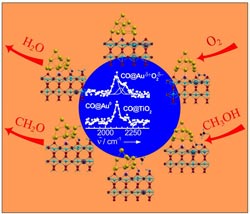Mysterious catalyst explained: how tiny gold particles aid the production of plastic components

Gold/titanium dioxide catalyst in action: At the interface between a gold particle (Au, gold) and the titanium dioxide surface (TiO2, red and light blue), an oxygen molecule (O2, dark blue spheres) is activated by a charge transfer and becomes catalytically active. Thus, methanol (CH3OH) can be efficiently and selectively oxidized to formaldehyde (CH2O); water (H2O) is produced as well. The researchers made the charge transfer visible using vibrational spectroscopy of adsorbed carbon monoxide (CO; middle of the figure): In the presence of oxygen, a new band (CO@Au(delta+)O2(delta-) appears in the spectrum.<br>Image: M. Farnesi Camellone, D. Marx<br>
From methanol to formaldehyde – this reaction is the starting point for the synthesis of many everyday plastics. Using catalysts made of gold particles, formaldehyde could be produced without the environmentally hazardous waste generated in conventional methods.
Just how the mysterious gold catalyst works has been found out by theoretical and experimental researchers at the Ruhr-Universität Bochum in a cooperation project. In the international edition of the journal “Angewandte Chemie” they report in detail on what happens on the gold surface during the chemical reaction.
“Gold should not really be suitable as a catalyst.”
“That nanoparticles of gold actually selectively transform methanol into formaldehyde is remarkable”, says Prof. Dr. Martin Muhler of the Laboratory of Industrial Chemistry at the RUB. “As a stable precious metal, gold should not really be suitable as a catalyst.” However, gold particles of a few nanometres in size, anchored to a titanium dioxide surface, fulfil their purpose. You only need oxygen to set the reaction in motion, and the only waste product is water. How this is achieved is examined by Muhler’s team together with the groups of Prof. Dr. Dominik Marx of the Chair of Theoretical Chemistry and Dr. Yuemin Wang of the Department of Physical Chemistry I.
Oxygen binds at the interface between gold and titanium dioxide
The chemists identified the active site of the catalyst, i.e. the point at which the oxygen and methanol bind and are converted to water and formaldehyde. Elaborate calculations by Dr. Matteo Farnesi Camellone showed that oxygen binds at the interface between titanium dioxide and gold particles. Since titanium dioxide is a semiconductor, and thus electrically conductive, a charge exchange between oxygen, gold particles and titanium dioxide is possible here. Oxygen vacancies in the titanium dioxide further favour this charge transfer. Electrons transitionally transfer from the catalyst to the oxygen molecule. This allows the methanol to bind to the gold particles. In several further reaction steps, formaldehyde and water form. The solid, which consists of gold and titanium dioxide, is in the same state at the end of the reaction cycle as at the beginning, and is thus not consumed.
Experiment and theory: only the combination makes it possible
The RUB team clarified the individual reaction steps in detail. The researchers used computer simulations, so-called density functional calculations, and various spectroscopic techniques, namely, vibrational spectroscopy (HREELS method) and thermal desorption spectroscopy. In his model calculations, Dr. Farnesi quantified the charge exchange taking place during catalysis. Extremely sensitive vibrational spectroscopic measurements by Dr. Wang’s group confirmed the consequences of the charge transfer in the real system. “Through an intensive cooperation between theory and experiment, we have been able to qualitatively and quantitatively explore the active site and the entire reaction mechanism of this complex catalyst”, stresses Prof. Marx.
Funding
The study originates from the Collaborative Research Centre 558 “Metal-substrate interactions in heterogeneous catalysis”, which ended mid-2012. “The results are, so to speak, the crowning glory of the SFB works on alcohol oxidation”, Muhler sums up. The project was further actively funded by the Cluster of Excellence “Ruhr Explores Solvation” RESOLV (EXC 1069), approved by the German Research Foundation (DFG) in 2012, in which researchers investigate the selective oxidation of alcohols in the liquid phase.
Bibliographic record
M. Farnesi Camellone, J. Zhao, L. Jin, Y. Wang, M. Muhler, D. Marx (2013): Molecular understanding of reactivity and selectivity for methanol oxidation at the Au/TiO2 interface, Angewandte Chemie International Edition, DOI: 10.1002/anie.201301868
Further information
Prof. Dr. Martin Muhler, Laboratory of Industrial Chemistry, Faculty of Chemistry and Biochemistry at the Ruhr-Universität, 44780 Bochum, Germany, Tel. +49/234/32-28754, E-mail: muhler@techem.rub.de
Prof. Dr. Dominik Marx, Chair of Theoretical Chemistry, Faculty of Chemistry and Biochemistry at the Ruhr-Universität, 44780 Bochum, Germany, Tel. +49/234/32-28083, E-mail: dominik.marx@theochem.rub.de
Further press releases on this topic
http://aktuell.ruhr-uni-bochum.de/pm2013/pm00053.html.en
Editor: Dr. Julia Weiler
Media Contact
More Information:
http://aktuell.ruhr-uni-bochum.de/pm2013/pm00053.html.enAll latest news from the category: Life Sciences and Chemistry
Articles and reports from the Life Sciences and chemistry area deal with applied and basic research into modern biology, chemistry and human medicine.
Valuable information can be found on a range of life sciences fields including bacteriology, biochemistry, bionics, bioinformatics, biophysics, biotechnology, genetics, geobotany, human biology, marine biology, microbiology, molecular biology, cellular biology, zoology, bioinorganic chemistry, microchemistry and environmental chemistry.
Newest articles

NASA: Mystery of life’s handedness deepens
The mystery of why life uses molecules with specific orientations has deepened with a NASA-funded discovery that RNA — a key molecule thought to have potentially held the instructions for…

What are the effects of historic lithium mining on water quality?
Study reveals low levels of common contaminants but high levels of other elements in waters associated with an abandoned lithium mine. Lithium ore and mining waste from a historic lithium…

Quantum-inspired design boosts efficiency of heat-to-electricity conversion
Rice engineers take unconventional route to improving thermophotovoltaic systems. Researchers at Rice University have found a new way to improve a key element of thermophotovoltaic (TPV) systems, which convert heat…



